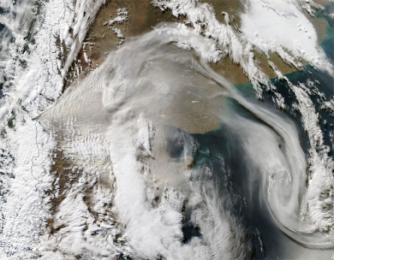NASA Provides a Two-Satellite View and Video of the Chilean Volcano Eruption
NASA's Aqua satellite and the GOES-13 satellite both captured their own unique views of the eruption of the Puyehue-Cordón Caulle volcano in Chile this week. One satellite provided a high-resolution image of the ash plume while the other provided a video showing the plumes movement over several days.
NASA's GOES Project released a satellite animation of the Puyehue-Cordón Caulle volcano that shows the movement of the ash plume over several days. The NASA GOES Project, located at NASA's Goddard Space Flight Center, Greenbelt, Md. created the animation from images obtained by the Geostationary Operational Environmental Satellite, GOES-13. The GOES series of satellites are operated by NOAA.
The GOES-13 animation includes visible and infrared imagery from GOES-13 that runs from June 4 at 1745 UTC (1:45 p.m. EDT) to June 6 at 1445 UTC (10:45 a.m. EDT). On June 4, the plume was blowing to the southeast. Through June 5 and 6, the winds shifted and viewers of the animation can see the plume start turning in a counterclockwise motion to the east, northeast and then north as high pressure moves in (In the south high pressure system winds rotate opposite they way they do in the northern hemisphere, so they shifted the winds from southeast to the north.
A visible image was taken on June 8 at 18:30 UTC (2:30 p.m. EDT) by the Moderate Resolution Imaging Spectroradiometer (MODIS) instrument that flies aboard NASA's Aqua satellite. The plume from the Puyehue-Cordón Caulle volcano in Chile has now expanded to the south and is now covering a much wider angle than earlier this week. The image shows the plume of ash now blowing to the east over Argentina in what almost appears to be a 90 degree triangle.
The MODIS Rapid Response Team is also located at NASA Goddard, and creates images from the MODIS instrument that flies aboard NASA's Aqua and Terra satellites.
According to MSNBC on June 8, flights in and out of Chile, Argentina and Buenos Aires, Brazil were suspended or delayed over the last several days and travelers should check with their airlines. The Associated Press and CBS News noted that the organization in Chile that monitors volcanic eruptions: the National Geology and Mines Service considers the eruption moderate so far, but it could change.
Meanwhile, satellite data from NASA and NOAA will help airlines determine the direction of the ash plumes and whether air travel can resume.
www.nasa.gov/topics/earth/features/20110609-volcano.html
ESA's image of the week
Earth from Space: A gush of volcanic gas, 10 June 2011
This image shows the huge plume of sulphur dioxide that spewed from Chile’s Puyehue-Cordón Caulle Volcanic Complex, which lies in the Andes about 600 km south of Santiago.
After lying dormant for more than 50 years, a series of rumbling earthquakes signalled the beginnings of this major volcanic eruption. On 4 June, a fissure opened, sending a towering plume of volcanic ash and gas over 10 km high.
Several thousand people were evacuated as a thick layer of ash and pumice fell and blanketed a wide area. Airports in Chile and Argentina were closed as a result.The image was generated on 6 June using data from the Infrared Atmospheric Sounding Interferometer on Eumetsat’s MetOp-A satellite. As the eruption continued, the image shows how strong winds initially swept the broad plume of sulphur dioxide northwards and then eastwards across Argentina and out over the southern Atlantic Ocean.
Strong westerly winds are common in this region because it lies within the belt of the ‘Roaring Forties’. Since there is little land south of 40º, higher wind speeds can develop than at the same latitudes in the Northern Hemisphere.
Interestingly, over the South Atlantic, the plume take a sharp turn to the north as a pressure system causes the wind to change direction.
The Puyehue-Cordón Caulle complex is a chain of volcanoes that includes the Puyehue volcano, the Cordilera Nevada caldera and the Cordón Caulle rift zone. This event appears to have stemmed from the rift zone and is the most serious since the eruption of 1960, also from the same vent.
Chile has more than 3000 volcanoes, of which around 80 are currently active.
The image represents sulphur dioxide concentrations within the full vertical column of atmosphere. It was generated using data from the interferometer, which was developed by the French space agency CNES for MetOp-A.
The MetOp programme was jointly established by ESA and Eumetsat and forms the space segment of Eumetsat’s Polar System.

